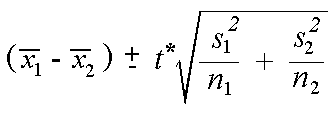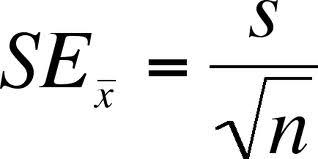The number of standard deviation units a sample mean falls from a known population mean.
What does the one sample t statistic tell me?
We want to compare the average scores (means) of two different samples, representing two distinctly different populations (and we do not have any information, mean/standard deviation about those populations).
What is the purpose of running an independent sample t test?
A research design we use a related sample t test to analyze where a group is first tested, they then receive some kind of intervention/therapy/treatment and then are re-tested to assess the treatment's effectiveness.
What is a pre-test post-test design?

In the formula for calculating the 95% CI for an Independent sample t test, the "t" represents this value.
What is the critical t (in the tail) for an alpha of .05?
the measure of effect size we get when we subtract the means of our two samples and divide by the pooled sample standard deviation.
What is the estimated cohen's d for an independent sample t test?
This is the population parameter we do not have when attempting to compare the known mean of a population against our sample mean.
What is the population standard deviation?
The name of the research design that requires the use of an independent sample t test to analyze the data.
A research design we use a related sample t test to analyze where we have two different experimental conditions (e.g., the effect of sweet and bitter tastes on a reaction time task) and every participant experiences both of those conditions.
What is a within-participants design?
When establishing a confidence interval, we typically use this % to represent the range of scores that we think the population mean will fall between.
What is 95%?
The magnitude of the effect size when we get an estimated Cohen's d = -1.75
What is a large effect size?
One of the three assumptions we need to compute a one sample t test. It states "We assume that the data points in the population are normally distributed around the population mean."
What is the assumption of normality?
One of the assumptions that must be satisfied to run an independent sample t test. It states "We assume that the variances of the population distributions being represented by the two samples we're comparing are approximately equal."
What is the assumption of equal variances?
When running a related sample t test, the dependent variable (the data being analyzed) are always these:
What are difference scores?
The proper decision to make when the null hypothesis mean falls outside of the 95% confidence interval you establish.
What is rejecting the null hypothesis?
A measure of effect size that tells you the proportion of total variability in your data that you can attribute to the treatment as opposed to error.
What is eta squared?

What is the unbiased estimate of the population's standard error? (also accepted: What is the numerator for the denominator of the t-statistic formula).
df1 + df2
(n-1) + (n-1)
N - 2
What are three strategies for calculating the degrees of freedom for an independent sample t-test.
This is an assumption that must be satisfied to complete an independent sample t test, but is not a required assumption for the related sample t test.
What is the assumption of equal variances?
The decision to retain the null (when doing a confidence interval for a related samples t test).
What is the proper decision when the null hypothesis score of 0 falls between the upper and lower bound of a 95% confidence interval?
Cohen's d is unaffected by this value when conducting a study.
What is n (i.e., sample size)?
When testing whether a group (i.e., sample) of people have average intelligence, this is how we would write out the null hypothesis statement.
What is H0: μ = 100
The term I need to calculate FIRST before I can calculate the estimated standard error of the difference in the formula for my independent sample t test.
What is the pooled sample variance?
If I had a sample of 15 people (n = 15) and each individual were tested before and after a treatment (pre-test/post-test design). This would be my degrees of freedom:
What is 14?
The score I'd get for the upper boundary of my confidence interval for a one-sample t test if I had a sample mean of "10" a critical t of "2" and an estimated standard error of "1"
What is 12?
The effect size I have (according to the effect size conventions given on p. 239 of the textbook) when 75% of the variability in my data is attributable to error.
What is a large effect size?